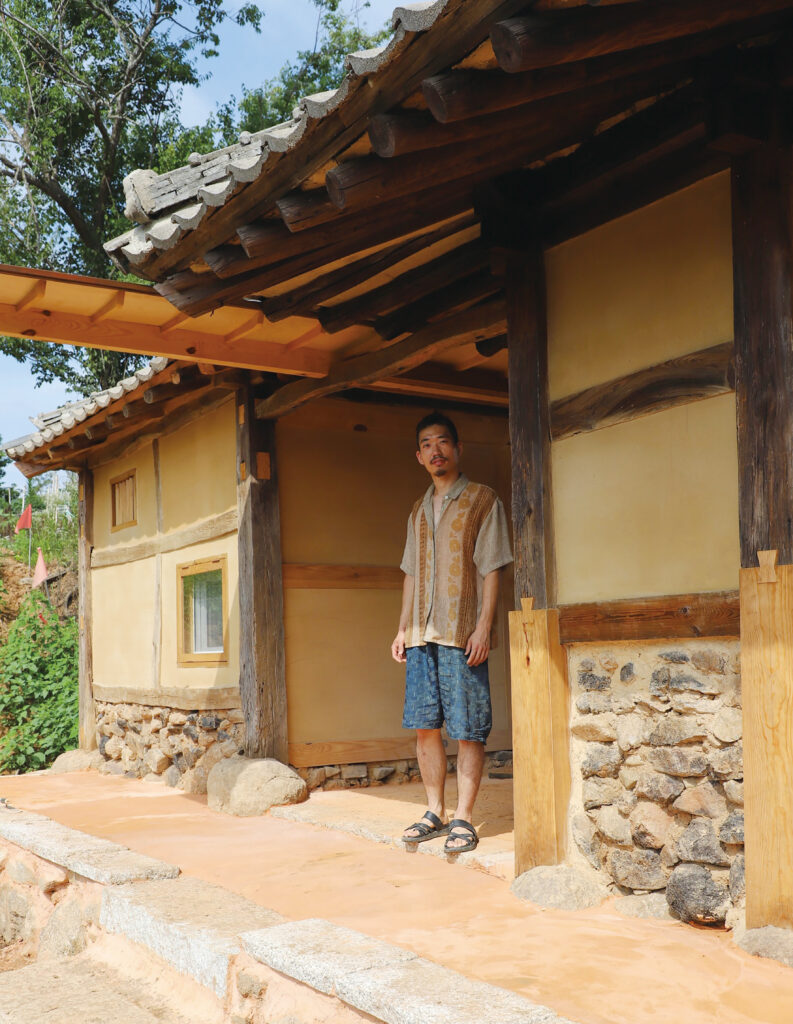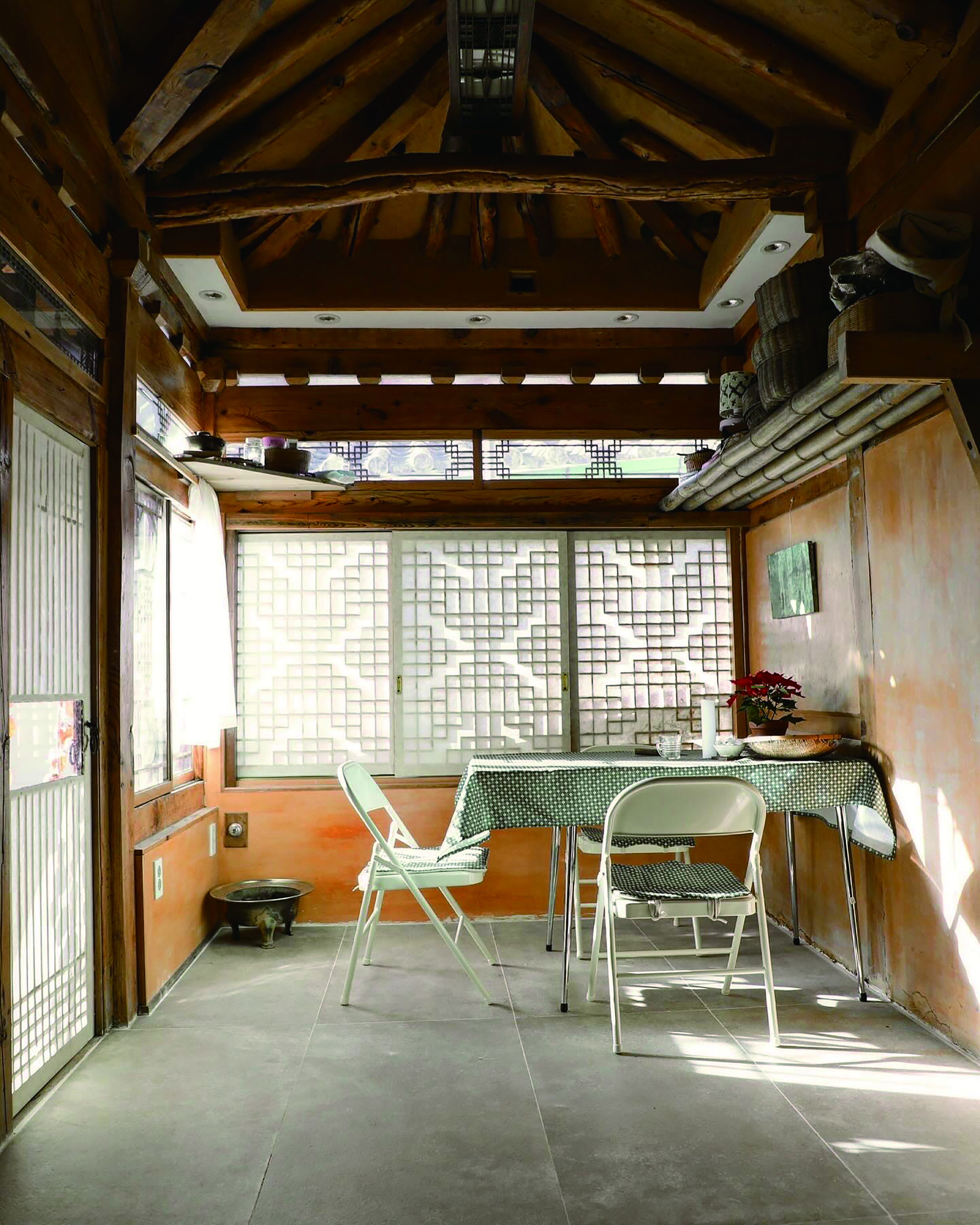Against the Grain
By Isaiah Winters

It’s not every day in Korea that you cross paths with a multicultural married couple in their twenties who are their own bosses, live in a restored hanok, and raise a newborn there. That’s why it’s always a pleasure to catch up with Kang Dong-su, my hanok-restoring friend who goes against society’s grain and somehow comes out with an enviably smooth finish. What follows is us catching up since the last time we met in July 2023 (Gwangju News, issue 257).
Isaiah Winters (IW): A lot has changed since the last time we met. Last summer, we were peeling through layers of old hanok wallpaper for your wallpaper archive, and since then, you’ve launched your own wallpaper business. Tell us a bit about that.
Kang Dong-su (Dong-su): Since last summer, our journey has taken an exciting turn. Inspired by our explorations through layers of old hanok wallpaper for the wallpaper archive, we’ve taken on a new venture – the launch of our own wallpaper business, Gosaté.
As you might recall, our other company, Baemui, focuses on archiving, researching, and restoring disappearing architectural heritage sites, especially hanok, in Korea. The turning point came during the demolition of a hanok built in 1893, where we discovered layers of wallpaper dating back to the early 1910s featuring patterns and imprints from the Japanese newspaper Asahi Newspaper during World War I.
Motivated by this find, we embarked on a meticulous process of scanning and archiving each type of wallpaper discovered in hidden nooks of several hanok undergoing remodeling. These wallpaper remnants, representing diverse eras and designs, were often discarded during home renovations, prompting us to think about their historical and cultural significance.
Our latest business, Gosaté, aims to revive and preserve Korea’s once-vibrant wallpaper culture. We’ve launched a brand that not only sells restored wallpaper but also serves as a platform to showcase the rich tapestry of Korea’s wallpaper heritage. “Gosaté” (고샅에) is a fusion of the word gosat (고샅), meaning an “alley” or “lane” in Korean, and the Korean postposition é (에) with a stylized French accent marker, which in sum means “in the alley.” The name reflects our commitment to exploring alleyways, old city centers, and rural villages to rediscover forgotten treasures.
Presently, Gosaté features a collection ranging from late-Joseon woodblock-printed wallpaper to those from the 1980s, encapsulating a century of Korea’s modern history. These wallpaper remnants are digitally restored and produced in collaboration with a Swedish wallpaper manufacturer. They’re available for purchase on our website, www.gosate.kr. While we don’t disclose all types of wallpaper we’ve collected, we also collaborate with filmset designers and offer pattern authentication services to institutions and restoration firms.
IW: How do you get from finding a dusty old strip of wallpaper in some abandoned hanok to delivering colorful rolls of freshly printed wallpaper to people’s doors? Walk us through that process.
Dong-su: The process begins on-site, where we collect layers of thick, decades- to century-old wallpaper from abandoned hanok. These wallpaper bundles are brought to the workshop and meticulously separated, often with the help of steam or dampening to reveal detailed information. While the wallpaper is still moist, we scan or photograph it, creating a digital archive. The scanned patterns are then sorted and stored chronologically in our wallpaper storage facility.
Next, the digitization process takes place. Using an iPad and Apple Pencil, each pattern is traced and its colors adjusted. Some patterns undergo modifications to make them commercially viable, with adjustments to color schemes or overall aesthetics. After several rounds of sample work to refine the designs, the final digital files are prepared.
For patterns deemed suitable for commercial use, we place orders with said wallpaper manufacturer in Sweden. The freshly printed wallpaper orders are promptly shipped directly to customers, ensuring they receive vibrant rolls of wallpaper at their doorstep.
IW: That’s about as niche as it gets! And while you’ve got these two businesses running in the background, you’ve had some intensive “housekeeping” going on, too. Over the last few months, you’ve completed many of the long-term renovation projects inside your hanok. That must be very satisfying for a carpenter like you. What are some of the biggest changes you’ve made, and what were some of the greatest challenges?
Dong-su: Our home, built in 1972, is a typical example of mass-produced hanok in Gwangju, as featured in the Gwangju News on five occasions. It’s located on the site of the former Gyeongyang Bangjuk, an artificial lake created during the mid-Joseon period. Originally serving as a dike, Gyeongyang Bangjuk was partially filled in during the Japanese colonial era and repurposed as a lake for a city park. However, in 1968, due to the need for funds for the Geumnam-ro street expansion project, Gwangju completely filled in and sold the land to developers for the construction of mass-produced hanok. Our house is one of those built during that time.
In 2020, we repaired part of the house (kitchen-dining room) for use, and by the summer of 2023, we remodeled the living room and loft and added a bedroom. Future remodeling projects include a loft to be used as a couple’s bedroom, a second bathroom, and an office space. We plan to address this latter area with more consideration, as it’ll become the office space for Gosaté.
One of the core considerations during renovation was insulation, along with a key principle guiding all my work: preserving old elements as much as possible. For spaces like the kitchen, where insulation was less critical, we exposed the old walls and structures. In contrast, for the newly created spaces like the living room, loft, and bedroom, we focused on insulation, using thick walls and ceiling insulation of up to 30 cm. Basic structures like beams and columns were left exposed.
Throughout the renovations, I paid attention to reusing old materials. For example, I reused a beam found in a heap of demolition debris in my grandmother’s neighborhood, which was inscribed with building information. I also repurposed a wooden door from an old house near Iksan Station and a sliding door from a two-story house in Dongmyeong-dong, Gwangju, dating back to the 1970s.
IW: Speaking of repurposing things, have you used any of Gosaté’s “new old” wallpaper in your home? Which pattern(s) did you go with and why?
Dong-su: We’ve applied one of the restored Korean wallpaper products from the 1950s on the wall of our kitchen cabinet. This particular pattern, estimated to date back to the 1950s, has been found nationwide, including areas like Ganghwa Island in Incheon and Damyang in Jeollanam-do. To delve into the history of the pattern, it draws inspiration from the grapevine motif symbolizing Jesus found in the Byzantine Empire and Orthodox-style crosses. This pattern spread widely and was even used in the Ottoman Empire, which practiced Islam. Over time, it reached Korea at the end of the Joseon Dynasty, underwent various adaptations during the Japanese colonial period, liberation, and subsequent war, making it difficult to trace the original source.
The wallpaper found in Damyang, Ganghwa Island, and other locations nationwide exhibit variations in their shapes. These wallpaper patterns were not mass-produced in a single workshop but copied and reproduced in various studios. In contrast to Western patterns, these Korean patterns have a flat composition reminiscent of folk paintings (minhwa, 민화), and the presence of a cross pattern with star motifs and target markings in the center evokes wartime imagery. This aspect reflects the historical context of 1950s Korea, especially the period around the Korean War.
Due to material shortages, the wallpaper from this era was limited in terms of colors, often featuring the same ink for different patterns. They primarily used black, red, and green hues. These limited yet distinct colors, reminiscent of Christmas aesthetics, earned my wife’s admiration, prompting us to choose the kitchen, her favorite space, as the perfect spot for this wallpaper.
IW: Speaking of Christmas, probably the biggest change that’s taken place since we last met is your new role as a father. I presume many of your home renovations were in anticipation of bringing a child into the world last December, so please tell us about life as a new parent.
Dong-su: Yes, a few weeks ago, I became a father. Fortunately, our son was born around the due date, and the whole process at the hospital took only about two hours. The childbirth wasn’t too challenging for my wife, and we’re taking good care of him at home without going to a postnatal care center. He’s been breastfeeding well since birth.
We named him San. Combined with my surname, Kang, the name “Kang San” can also mean “river and mountain,” which is a metaphor for the landscape of Korea. We also chose this name for its ease of pronunciation in Western countries, considering our multicultural family background.
Personally, although we don’t follow any specific religion, we also considered the Catholic cultural background of my wife’s family. So, “San” was chosen to imply “Saint” in addition to its natural landscape reference. Interestingly, my wife’s grandmother, who’s Catholic, had predicted that he might be born on Christmas, so she was delighted that he was indeed born on Christmas Day, especially as he was born to a carpenter family, which she found quite special. Additionally, since my wife’s hometown is near the Alps, she liked the mountain connotation in his name.
Our son is growing healthily, and one interesting characteristic is that even before he turned a week old, he was captivated by looking at the ceiling and following moving objects with his gaze, indicating a sensitivity to visual stimuli earlier than other babies. This seems to be a trait he inherited from me. We hope he continues to grow healthily and happily.
IW: Little San’s already got quite the origin story! What are some things you’re most looking forward to in 2024?
Dong-su: First and foremost, I hope our son smoothly navigates his first year to celebrate his traditionally important first birthday, his dol (돌). As my work often requires extended business trips, I hope to be able to work as close to Gwangju as possible.
In terms of projects, we’re currently in the process of remodeling a hanok built in 1945 near the beach on Ganghwa Island, scheduled to be completed this spring. Regarding our wallpaper business, while it hasn’t generated significant profits yet, I hope it thrives in the coming year.
Additionally, though there aren’t concrete plans at the moment, I’m considering a future project involving disassembling hanok in redevelopment areas facing demolition threats, packing them into shipping containers, and exporting them overseas. For over a decade, I’ve been involved in various attempts to preserve Korea’s old structures. However, recognizing the limitations in domestic demand and the rapid development that causes traditional hanok and architectural cultural heritage sites to disappear, I wonder if relocating them abroad might ensure their documentation and survival. I’m currently conducting surveys of potential interest in America, Europe, Asia, and elsewhere. Recently, I’ve received inquiries from a museum in the United States regarding shipping hanok, indicating some progress in this direction. I believe there are various possibilities for utilization overseas, including private residences, villas, pavilions, and museum/gallery exhibition spaces.
IW: I hope this becomes business number three. If it does, it’ll definitely merit another interview. Best of luck with everything in 2024!
The Author
Hailing from Chino, California, Isaiah Winters is a pixel-stained wretch who loves writing about Gwangju and Honam, warts and all. He’s grateful to have written for the Gwangju News for over five years. More of his unique finds can be seen on Instagram @d.p.r.kwangju and YouTube at Lost in Honam.



